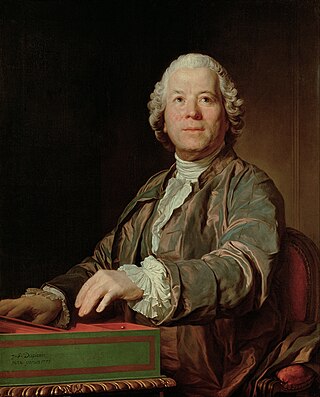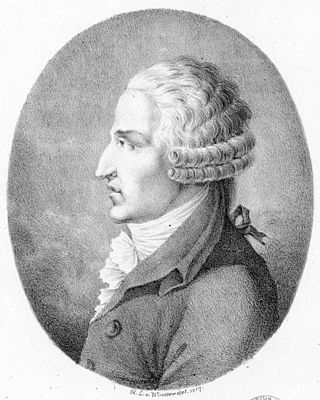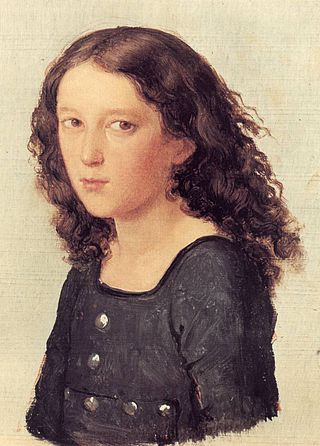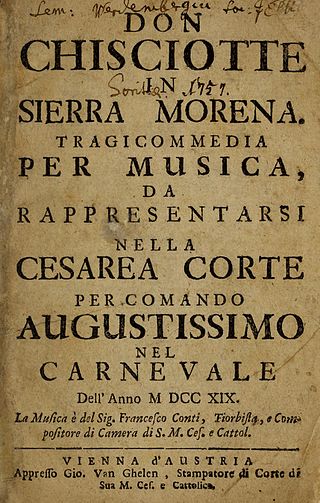
Antonio Salieri was an Italian composer and teacher of the classical period. He was born in Legnago, south of Verona, in the Republic of Venice, and spent his adult life and career as a subject of the Habsburg monarchy.

Christoph WillibaldGluck was a composer of Italian and French opera in the early classical period. Born in the Upper Palatinate and raised in Bohemia, both at the time part of the Holy Roman Empire, he gained prominence at the Habsburg court at Vienna. There he brought about the practical reform of opera's dramaturgical practices for which many intellectuals had been campaigning. With a series of radical new works in the 1760s, among them Orfeo ed Euridice and Alceste, he broke the stranglehold that Metastasian opera seria had enjoyed for much of the century. Gluck introduced more drama by using orchestral recitative and cutting the usually long da capo aria. His later operas have half the length of a typical baroque opera.

Opera seria is an Italian musical term which refers to the noble and "serious" style of Italian opera that predominated in Europe from the 1710s to about 1770. The term itself was rarely used at the time and only attained common usage once opera seria was becoming unfashionable and beginning to be viewed as something of a historical genre. The popular rival to opera seria was opera buffa, the 'comic' opera that took its cue from the improvisatory commedia dell'arte. An opera seria had a historical or Biblical subject, whereas an opera buffa had a contemporary subject.

Pasquale Anfossi was an Italian opera composer. Born in Taggia, Republic of Genoa, he studied with Niccolò Piccinni and Antonio Sacchini, and worked mainly in London, Venice and Rome.

Anastasio Martín Ignacio Vicente Tadeo Francisco Pellegrin Martín y Soler was a Spanish composer of opera and ballet. Although relatively obscure now, in his own day he was compared favorably with his contemporary and admirer, Wolfgang Amadeus Mozart, as a composer of opera buffa. In his time he was called "Martini lo spagnuolo" ; in modern times, he has been called "the Valencian Mozart". He was known primarily for his melodious Italian comic operas and his work with Lorenzo Da Ponte in the late 18th century, as well as the melody from Una cosa rara quoted in the dining scene of Mozart's Don Giovanni.

Prima la musica e poi le parole is an opera in one act by Antonio Salieri to a libretto by Giovanni Battista Casti. The work was first performed on 7 February 1786 in Vienna, following a commission by the Emperor Joseph II. The opera was first performed at one end of the orangery of the Schönbrunn Palace in Vienna by an Italian troupe; simultaneously, Mozart's Der Schauspieldirektor was staged at the other end.

La scuola de' gelosi is a dramma giocoso in two acts by Antonio Salieri, set to a libretto by Caterino Mazzolà.

Falstaff, ossia Le tre burle is a dramma giocoso in two acts by Antonio Salieri, set to a libretto by Carlo Prospero Defranceschi after William Shakespeare's The Merry Wives of Windsor.

La fiera di Venezia is a three-act opera buffa, described as a commedia per musica, by Antonio Salieri, set to an Italian libretto by Giovanni Gastone Boccherini.
Francesco Carattoli was an Italian bass buffo, or singer of opera buffa.

Ludwig Minkus, also known as Léon Fyodorovich Minkus, was an Austrian composer of ballet music, a violinist and teacher of music.

Die Hochzeit des Camacho is a Singspiel in two acts by Felix Mendelssohn, to a libretto probably written largely by Friedrich Voigts, based on an episode in Don Quixote by Cervantes. The opera is listed as Mendelssohn's op. 10. It was written between 1824 and 1825, and first performed publicly at the Berlin Schauspielhaus on 29 April 1827.

Vincenzo Maria Righini was an Italian composer, singer and kapellmeister.
Gennaro Astarita was an Italian composer, mainly of operas. The place of his birth is unknown, although he was active in Naples for many years. He began his operatic career in 1765, collaborating with Niccolò Piccinni in the writing of the opera L'orfana insidiata. He became the maestro di cappella in Naples in 1770.

Le crescendo is a comic opera in one act by Luigi Cherubini with a libretto by Charles Augustin [de Bassompierre] Sewrin. The libretto is based on the opera buffa L'Angiolina ovvero Il matrimonio per sussurro with music by Antonio Salieri and by Valentino Fioravanti.

L'amore innocente composed by Antonio Salieri (1750–1825), is an Italian-language opera in two acts. Stylistically, it is a pastoral opera and is very similar to the mid-18th-century Roman Intermezzo. The libretto was written by Giovanni Gastone Boccherini, dancer, poet and stage manager, brother of the composer Luigi Boccherini.

Le donne letterate, composed by Antonio Salieri, is an Italian opera in three acts. Stylistically it is an opera buffa and is very similar to the mid-18th century librettos of Carlo Goldoni. The libretto by Giovanni Gastone Boccherini, dancer, poet and stage manager, brother of the composer Luigi Boccherini, was based on Molière's Les Femmes Savantes.

Il curioso indiscreto, is an opera in three acts composed by Pasquale Anfossi. The libretto is based on an episode from the 17th-century Spanish novel Don Quixote. The librettist is not known for sure but is thought to be either Giovanni Bertati or Giuseppe Petrosellini. The opera premiered at the Teatro delle Dame in Rome during the Carnival season of 1777.

Don Chisciotte in Sierra Morena is a tragicomic opera in five acts composed by Francesco Bartolomeo Conti to an Italian libretto by Apostolo Zeno and Pietro Pariati. The libretto is based on the episodes set in the Sierra Morena mountains of Spain in Book I of the Miguel de Cervantes novel Don Quixote. The opera premiered on 6 February 1719 at the Hoftheater in Vienna and proved to be one of Conti's most successful ones. It has had several revivals in modern times beginning in 1987 at the Buxton Festival.













